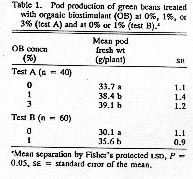We tested “Roots” (Lisa Products Corp., New Haven, Conn.), a proprietaiy mixture of hunaic acids, marine algae extracts, thia- mine, and ascorbic acid. The objective of this study was to assess the effectiveness of this organic biostimulant (OB) on pod pro- duction of green beans (Phaseolus vulgaris
Under postal regulations, this paper therefore must be hereby marked adveflisemen: solely to indicate this fact.
Berkeley, Calif.) The seedlings were grown in three treatments of 40 plants each to eval- uate Roots: 1)0% (control), 200 ml tap watcr/ plant when others were treated with OB; 2) 1%, two applications of 200 ml to each plant (at transplanting and on day 26 after trans- planting as a soil drench), and 3) 3%, two applications of 200 ml to each plant on the same dates as in 2) above. In lest B, a second set of 120 seedlings was transplanted and grown in two treatment groups of 60 plants each to further test the effectiveness of the OB at 1%: 1) control, 100 ml tap water/plant when others were treated with OB; and 2) three applications of OB at 100 ml to each plant (at transplanting and on days 26 and 45 after transplanting). An analysis of the medium by the Morgan method (Lunt CE al., 1950) before any treatment showed the mix was slightly acidic (pH 6.4), was medium- low in nitrate nitrogen (<4 ppm), low in ammonium nitrogen (<12 ppm), medium in P (<100 ppm), high in Ca (>1500 ppm), and high in Mg (>100 ppm). Temperature in the greenhouse was always between 15 and 30C. Relative humidity was not con- trolled, and it ranged from 70% to 100%. Pollutants were not filtered out. Plants were fertilized once with 150 mg N/liter (15N— 13P—12.5K, Stern’s Miracle-Gao Products, Port Washington, N.Y.) 2 weeks after trans- planting in both tests.
In test A, pods were harvested 85 days after sowing and 59 days after transplanting; in test B they were harvested 64 days after sowing and 56 days after transplanting. Pod maturity was gauged subjectively on the ba- sis of experience and pod physical proper- ties. Pod fresh and dry weights per plant were determined. Water content (WC) was deter- mined by using the formula: WC = (Wf - Wd)/Wf x 100; where Wf is fresh weight and Wd is dry weight. Analysis of variance was performed on pod fresh weights.
The fresh weights of the pods of all bio- stimulant-treated groups were significantly higher than those of the control (P < 0.05).

Literature sited Aitken, J.B., B. Acock, and T.L Semi. 1964. The characteristica of humic acids derived from leonardite. South Carolina Agr. Expt. Sta., ae~ Univ., Tech. Bul. 1015. Berlyn, G.P. and R.O. Russo. 1990. The use of organic ~iiostimutants to promote root growth. Bclowgmund Ecology 2:12—13. Kinncrslcy, A.M., T.C. Scott flI, J.H. Yopp, and G.H. Whitten. 1989. Promotion of plant growth by polymers of lactic a~lH. Plant Growth Reg- ulat. 9(2):137—146. Lust, H.A., C.LW. Swanson, and H.G.M. Ja- cobson. 1950. The Morgan soil testing system. Connecticut Agr. Expt. Sta., New Haven. Poincelot, R.P. 1986. Toward a more sustainable agriculture. AVI, Westport, Conn. Russo, R.O. and G.P. Berlyn. 1990. The use of organic biostimulants to help low input sustain- able agriculture. I. Sustainable Agr. 1(2):19— Scnn, T.L 1987. Seaweed and plant growth. T.L Sean, Pub., acn~,n, S.C. Scnn, T.L and A.R. Kingman. 1973. A review of humus and humic adds. The South Carolina Agr. Expt. Sta., aemson Univ., Res Scrics. no. 145.
|